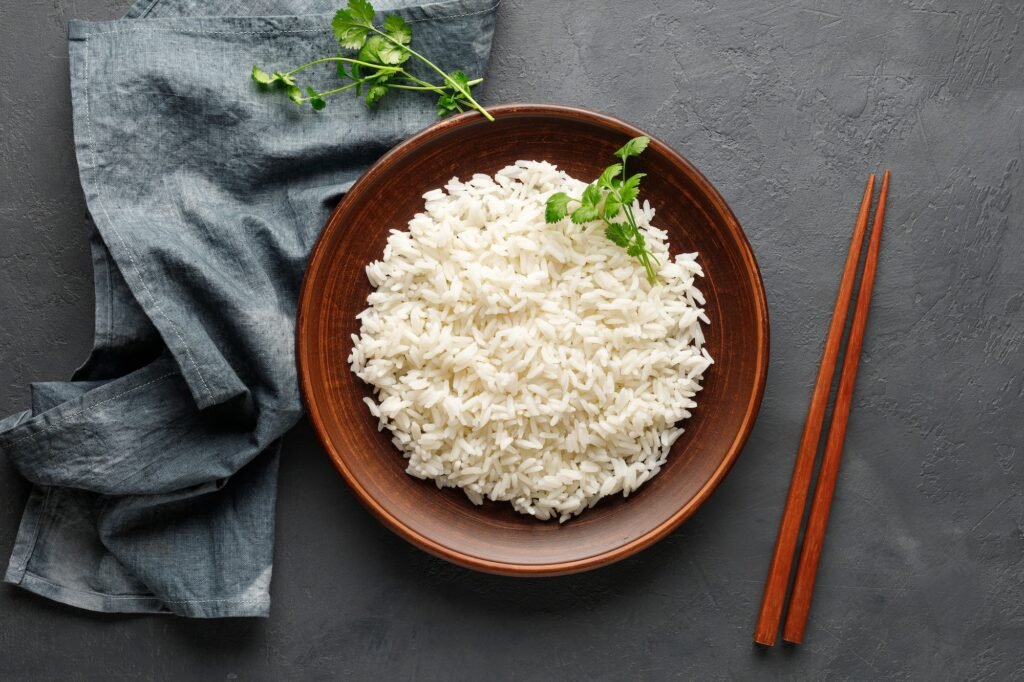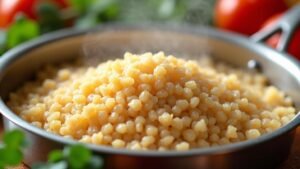Have you ever wondered how your rice cooker knows when to stop cooking? Well, the answer lies in the science behind rice cookers, which involves precise measurements of temperature, pressure, and timing.
In this article, we will explore the inner workings of a rice cooker and examine how it cooks rice to perfection.
We will delve into the technical aspects of its operation and explain why it stops cooking when the rice is done. If you want to get a fuller picture of how a rice cooker works then you can also read this post.
By understanding how your rice cooker works, you can improve your cooking skills and make delicious meals that are free from overcooked or undercooked grains of rice. So let’s dive into the fascinating world of rice cookers and discover what makes them tick!
Table of Contents
Some Background
Rice cookers, also known as automated rice steamers, are electronic kitchen appliances designed to automatically cook rice by sensing temperature and moisture levels during the cooking process. The history of rice cookers dates back to ancient China where people used earthenware pots to steam their grains.
However, it wasn’t until the 1950s when Japanese companies such as Toshiba and Panasonic developed electric rice cookers that revolutionized the way rice is cooked.
The evolution of rice cookers has been significant in terms of technology and design. Early models were simple devices with a single heating element that operated on a timer switch. Today’s models have multiple sensors that detect changes in temperature and moisture levels, advanced microprocessors that control the cooking process, and various settings for different types of grains. Some even come with additional features such as steaming trays for vegetables or meat.

The history and evolution of rice cookers have contributed significantly to their widespread use today. From simple earthenware pots to sophisticated electronic appliances with advanced features, these devices continue to make cooking rice an effortless task for millions of households worldwide.
With advancements in technology likely to continue, we can expect even further improvements in both functionality and efficiency for future generations of rice cookers.
The Science Behind Rice Cookers
One of the main factors behind a rice cooker’s ability to cook rice perfectly is its ability to measure temperature and moisture levels accurately. This is achieved through the use of various sensors that are able to detect changes in these parameters and adjust cooking time and heat accordingly.
The signals generated by these sensors are then used by the cooker’s control circuitry to ensure that rice is cooked thoroughly without becoming overcooked or undercooked.
Measuring Temperature and Moisture
Like a watchful gardener, the rice cooker’s temperature and moisture sensors carefully monitor the cooking process to ensure perfectly cooked rice every time.
Temperature control is essential in cooking rice, as it determines how long the rice needs to cook and at what temperature. Rice cookers employ an automatic shut-off mechanism that turns off the heat source when the temperature reaches a boiling point or above. This mechanism helps prevent overcooking of the rice and ensures that it is cooked evenly.

Moisture detection is another vital aspect of cooking rice, as it determines whether there is enough water for proper cooking or if there is excess water leading to mushy rice. Rice cookers come with built-in sensors that detect moisture levels during the cooking process. The sensor measures the amount of steam produced by boiling water within the container and uses this information to determine whether more water needs to be added or if some need to be removed. This technology ensures that your rice comes out fluffy, and moist but not soggy, and perfect every time you use your cooker.
Sensors and Signals
The precise and accurate detection of temperature and moisture levels in rice cookers is made possible by the advanced sensors and signals technology used within them. These sensors are calibrated to detect even minor changes in temperature and moisture, ensuring that the rice cooker knows exactly when to stop cooking. The calibration process involves setting up a reference point for both temperature and moisture levels, which is then used as a benchmark for future measurements. This ensures that the readings provided by the sensors are always accurate, which is critical for achieving perfectly cooked rice.
The signals generated by these sensors also play a key role in determining cooking time. For instance, if the sensor detects that there is too much moisture present, it may signal the rice cooker to increase its cooking time until the excess moisture has been evaporated.
Conversely, if there is too little moisture present, it may signal the rice cooker to decrease its cooking time or switch off entirely so as not to overcook the rice.
Overall, this careful interplay between sensors and signals ensures that users can consistently achieve perfect results with their rice cookers every single time they use them.
| Sensor Type | Function | Impact on Cooking Time |
|---|---|---|
| Temperature Sensor | Detects changes in temperature | Determines when heating should start/stop |
| Moisture Sensor | Measures water content in rice grains | Adjusts cooking time based on desired texture |
The table above highlights how different types of sensors impact cooking time based on their function within a rice cooker.
By providing an easy-to-understand breakdown of how each sensor contributes to overall performance, users can gain greater insight into how their appliance works and make more informed decisions about how best to use it.
The Rice Cooking Process
During the rice cooking process, water is absorbed by the rice grains, and the temperature of the cooker increases. As the temperature rises, starch molecules in the rice grains begin to break down and absorb moisture from the surrounding liquid.
This process, known as starch gelatinization, causes the rice to become softer and stickier.
To ensure that rice is cooked perfectly every time, modern rice cookers come equipped with various sensors and mechanisms. These include a thermostat that monitors the temperature inside the cooker, a timer that controls cooking duration, and pressure sensors that regulate steam release.
Some cookers also use fuzzy logic technology to adjust cooking time and temperature based on factors such as water absorption rate and grain type.
As a result of these features, modern rice cookers are able to determine when to stop cooking based on precise measurements of moisture content and internal temperature.
Once all water has been absorbed by the rice grains or evaporated into steam, the cooker automatically switches off or enters a keep-warm mode until it is ready for serving. Overall, this advanced technology makes it easy for anyone to prepare perfect fluffy white or sticky brown rice with minimum effort.
- The starch gelatinization process causes changes in texture
- Modern rice cookers incorporate multiple sensors
- Fuzzy logic technology adapts to different types of grain
- Precise measurements of moisture content determine when cooking should stop
The ‘Keep Warm’ Setting
The ‘Keep Warm’ setting is a feature found on most rice cookers that allows the cooked rice to be kept at an ideal temperature range until ready for consumption. Its purpose is to keep the rice warm and fresh without overcooking or drying it out.
The ideal temperature range for the ‘Keep Warm’ setting is between 60-65°C, which maintains the moisture content of the rice while preventing bacterial growth.
Purpose and Benefits
The ‘Keep Warm’ setting is a feature that ensures a rice cooker is an efficient way to prepare meals.
To better understand the purpose and benefits of the ‘Keep Warm’ setting, consider these three items:
- Imagine being able to cook your rice in advance and have it ready hours later without any loss of quality.
- Picture having peace of mind knowing your food will remain warm and safe for consumption while you focus on other tasks.
- Envision enjoying freshly cooked, warm rice anytime without having to reheat it in a microwave or on a stove.
By keeping the temperature of the cooked rice at an optimal level, usually around 140-150 degrees Fahrenheit (60-65 degrees Celsius), the ‘Keep Warm’ setting helps preserve its texture, moisture content, and flavor for extended periods.
This not only saves time but also reduces waste by preventing overcooking or drying out of leftover rice.
Also, since most modern rice cookers have automatic shut-off features that activate once cooking is complete, there’s no risk of burning or spilling over during use. That’s why, the efficiency and convenience offered by the ‘Keep Warm’ setting make it an indispensable tool for busy individuals who want healthy home-cooked meals with minimal effort.
Rice Cooker Maintenance
Proper maintenance of a rice cooker can not prolong its lifespan but can also ensure it continues to accurately sense when the rice is fully cooked.
One of the essential cleaning tips for a rice cooker is to clean it after each use. This means wiping down the exterior with a damp cloth and removing any leftover rice or debris from the cooking pot and lid.
Also, regularly descaling your rice cooker is crucial in preventing mineral buildup that could affect its performance.
Taking care of your appliance through regular cleaning and troubleshooting will keep your investment working as intended and save you money in the long run. Incorporating this maintenance into your routine will also provide peace of mind that your rice cooker is functioning correctly, ensuring perfectly cooked rice every time.
Conclusion
The science behind rice cookers involves the use of sensors, heat sources, and timers to determine when the rice is done.
Once cooking begins, the sensors are activated, detecting how much moisture remains in the pot. Once all of the water has been absorbed by the grains, the temperature inside the cooker rises rapidly, triggering a switch that turns off the heat source.
This ensures that no further energy is expended on cooking once all of the water has been absorbed.
So, as you can see, rice cookers utilize sophisticated technology to make perfectly cooked rice every time. With their advanced sensors and timers, these appliances are able to determine precisely when to stop cooking based on moisture levels and temperature readings.
However, regular maintenance is essential for ensuring optimal performance over time.
But, if you keep this in mind, rice cookers truly exemplify efficiency in action through their automated processes and precise execution of each step involved in preparing delicious fluffy grains of rice effortlessly every time!








